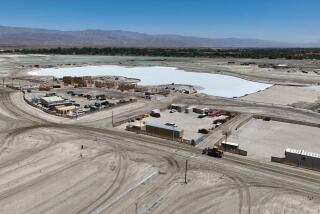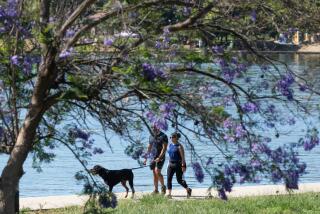At Desert Country Club, Sun Helps to Keep it Cool in the Pool
Itâs not in many parts of the world that the problem is cooling, not warming, the swimming pool, but the Coachella Valley desert is one of them.
Not all the time, of course; it can get mighty cool there at some seasons of the year and warming is still the biggest part of the pool-temperature regulating process. But cooling plays a significant role, particularly in the late summer, and a desert development is facing up to the need.
The things that make the installation at the Desert Falls Country Club highly unusual if not unique are (1) it is entirely solar; (2) it is one of the largest for the particular system being used--an eventual total of 24 pools in the planned 1,100-home development, and (3) the solar heating equipment can be ârun backwardâ through special nozzles to cool the pools.
The development is in Palm Desert, 10 miles or so farther down California 111 from Palm Springs for visitors coming from Riverside or Los Angeles, and the main entrance is on Country Club Drive near Cook Street, east of Bob Hope Drive.
âYou just run it backward for cooling,â was the phrase used by Francis Sullivan, principal of Sullivan Concrete Textures, when he was showing a visitor his Costa Mesa-based firmâs pool installations to date. One pool was complete--even to sun bathers--except for the cooling nozzles; the other was just a big hole in the ground.
The system uses the poolâs concrete deck as its solar collector panel. Coils four feet in diameter--the number is determined by the poolâs size--are buried in the deck, which is made of a special type of concrete called Solarpave and made by Bomanite.
Two pipes surround the deck; Sullivan said they are known in the industry as âmanifolds.â The coils are connected to them, an intake to each coil from the manifold that draws water from the pool and an output from each coil to the manifold that returns the heated water to the pool.
Both the coils and the manifolds are of plastic. Sullivan told his visitor that there have never been any maintenance problems with the coils under the decks. The manifolds are outside the deck and available for service or repair, buried deep enough to be out of the way of gardening tools such as edgers.
Anyone who has ever lain down on a pool deck in the middle of a sunny day in July or August knows that concrete exposed to the summer sun gets quite hot indeed. In the system used at Desert Falls, that heat is collected by the water running through the coils and moved to the pool. There is a welcome side-effect: So much heat is drained out of the concrete that the deck stays cool enough to lie down on without using a mat or splashing water on it.
The flow of water pumped through the warming coils and back into the pool is controlled by temperature sensors and the pumps are shut down when the pool is warmed to the predetermined level. Even so, it can get too hot.
All around the pool at five- or six-foot intervals are return pipes with spray nozzles on their ends. They barely protrude from the pool side. In the cooling operation, also automatically controlled by heat sensors, water is returned to the pool through the jets, spraying out just above the waterâs surface and cooling by evaporation before falling into the pool. Sullivan said swimmers have not complained about the sprays.
Of course, there are no operation-cost figures on the Desert Falls system yet, but Sullivan said it has been quite low on other systems he has installed, pointing out that the heating--normally the bulk of the cost--is free, coming from the sun, and therefore the only energy used is in the pumps and is about the same as in any poolâs filtration system.
Still drawing on experience with his firmâs previous systems, Sullivan conceded that there is some water loss from evaporation but said it is minimal.
Turning to installation costs, Sullivan gave figures for an 18-by-36-foot pool at a private house, one of his firmâs completed jobs. The Solarpave equipment--coils, manifolds and automatic controls--cost about $4,600. That does not include the decking itself, which would have had to be installed anyway. Jets for cooling would have added $800 to the total.
In one instance, Sullivanâs company found that there wasnât enough area in the pool decking to cover the necessary number of coils. But the job included a new driveway so the rest of the coils were placed under it, with excellent results.
The system can be used for an existing pool by placing the coils on the present decking and pouring the new Solarpave deck over it. It raises the height of the deck about six inches.
At Desert Falls Country Club, the first two phases, containing 187 homes, of the planned 11 phases have been completed; 124 have been sold and many are occupied. Two- and three-bedroom, two- and three-bath homes range from 1,125 to 1,836 square feet.
Five of the six floor plans are single-story, the other has a loft. Most of the homes are in two-unit structures.
The price range is $131,000 to $219,000 with 30-year financing at a fixed rate of 13 7/8% with 20% down. The $185 monthly homeownersâ association fee pays for upkeep of pools, spas and all common areas, as well as home exteriors and front-yard landscaping and fire insurance.
The developer is Pacific Coast Builders, Santa Ana, and the architect is Ballew & Associates, Dana Point. The landscaping is by Cardoza, Dillalo & Harrington, Irvine.
Recreational amenities, in addition to the pool complexes, include an 18-hole golf course with five tee placements for each hole, giving playing lengths from 5,405 to 7,070 yards, and 17 tennis courts, 10 of them lighted.
There are pro shops for both sports and a 30,000-square-foot clubhouse is on the way. Both golf and tennis club memberships of several sorts can be purchased if desired. There is no mandatory clubhouse fee.
More to Read
Sign up for The Wild
Weâll help you find the best places to hike, bike and run, as well as the perfect silent spots for meditation and yoga.
You may occasionally receive promotional content from the Los Angeles Times.






